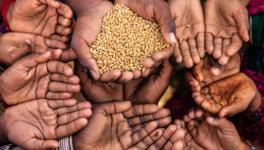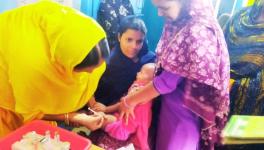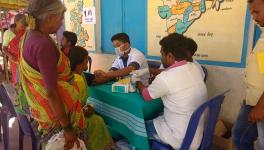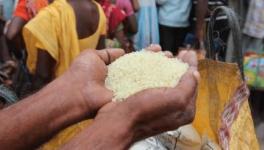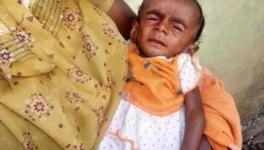Global Hunger Index May be Imperfect, but India Must Heed its Warning
Representational use only.
Health is regarded as an unalienable human right in the Universal Declaration of Human Rights. Children and adults can less utilise their full potential if they suffer from hunger, which unleashes a cycle of events that limit their choices and opportunities. The second of the United Nations Sustainable Development Goals has eight targets measured along fourteen indicators that aim to end hunger in the world. For these reasons, it is crucial to discuss the latest Global Hunger Index (GHI) for 2022, a joint report by Concern Worldwide and Welthungerhilfe.
Political parties conveniently use such indices to support their positions and programmes. However, we must view it as a crucial marker of the economic well-being of people.
India ranks 107 out of 121 countries with a GHI score of 29.1, making it among the lowest-ranked Asian economies, with only Afghanistan worse off. Countries with scores between 20 and 35 are considered to have severe hunger problems. India’s GHI scores are poorer than the 2014 figure of 28.2, which means hunger has increased since then. The hardships induced by the pandemic are one reason for the drop in the rankings, but it is also true that India’s neighbours have performed better despite the pandemic. Nepal ranked 81, Sri Lanka 64, Bangladesh 84, and Pakistan 99. In 2021, India ranked 101 among 116 countries.
How GHI is Calculated
Each country’s GHI score is based on a formula that combines four indicators that capture “multidimensional” hunger. These include undernourishment, or the share of the population with insufficient caloric intake; child stunting, or the share of children under five with a low height for age; child wasting, or the share of under-5 children who have low weight for their height; and, child mortality, or the share of children who die before their fifth birthday.
Undernourishment and child mortality get one-third of weightage, whereas child stunting and wasting get one-sixth. The GHI scores are on a 100-point scale, where 0 is the best (no hunger), and 100 is the worst.
India began marking improvements in the GHI in 2000, but concerns remain, especially regarding child nutrition.
-
Undernourishment dropped from 18.4% in 2000 to 14.8% in 2014 as a percentage of the population. However, the undernourishment rate rose to 16.3% in 2022, up by 1.5 percentage points from the previous year.
-
Child wasting has kept on rising in India. In 2022, prevalence will increase to 19.3% (the highest in the world) from 17.1% in 2000. Child wasting decreased to 15.1% in 2014, but there was a recent uptick.
-
Child Mortality, compared with 9.2% in 2000, the under-5 mortality rate is now only 3.3%.
-
Child stunting has decreased significantly from 54.2% in 2000 to 35.5%.
Government Rejects GHI Findings
The Ministry of Women and Child Development (WCD) has rejected and questioned India’s ranking, methodology, and data used to calculate the GHI 2022. It says the index is skewed and that three of the four indicators that make up the index are related to child health and, therefore, cannot be generalised. According to the ICMR, malnutrition, stunting, wasting, and infant mortality are not only caused by hunger but are also seen in the relatively well-off.
Claim 1: India’s undernourishment data is calculated on a small sample and relied on opinion polls.
According to the Indian government, the undernourishment data (based on the UN Food and Agriculture Organization’s Food Insecurity Experience Scale data) was from data used in a Gallup World Poll—an “opinion poll” with eight questions. The sample size for the poll was just 3,000 and was therefore not representative of the entire population.
However, the malnutrition indicators in the GHI are based on officially reported data by the UN member states, including India.
According to FAO, malnutrition prevalence has decreased in India since 2005, but the trend reversed in 2014. It then increased from 13.3% in 2017 to 16.3% in 2021, which equates to 22.4 crore (or 224 million) malnourished Indians.
Therefore, undernourishment data is not why India fell dramatically in the Global Hunger Index. After all, India has performed slightly better in undernourishment, rising from 14.8% to 16.3% between 2014 and 2022.
Several independent surveys in India, including those conducted by Right to Food Campaign and Azim Premji University, have confirmed the persistence or worsening of food insecurity during the pandemic.
Hunger Watch:
The Right to Food Campaign, in association with the Centre for Equity Studies and other organisations, conducted its first Hunger Watch survey after the national lockdown in 2020. Its second survey was conducted in 14 states from December 2021 to January 2022.
According to Hunger Watch II, malnutrition and food insecurity in India are very high. Even the fifth round of the National Family Health Survey shows improvements in malnutrition have slowed since 2015. The budgets for many social safety programmes have been declining for some years. For example, the Integrated Child Development Scheme (ICDS) funding faced a 38% cut in 2022-23 compared with 2014-15. The Mid-Day Meal Scheme (MDMS) has been slashed by nearly 50% in real terms.
Hunger Watch I showed a grave hunger situation, with 71% of households reporting lower nutrition quality and 66% reporting a decrease in the quantity of food consumed compared to before the lockdown. To identify food insecurity, Hunger Watch II used the Global Food Insecurity Experience Scale (GFIES), an eight-item scale many countries use. It showed that 80% of the sample reported food insecurity: 31% had mild food insecurity, 23% moderate, and 25% severe. More than 60% were concerned about not having enough food and could not access healthy or nutritious foods.
Families coped with hunger during the pandemic in various ways—bringing children out of school and into work, selling movable assets including jewellery, borrowing to buy food, and considerable reductions in the quantity and quality of food.
Claim 2: Three of four indicators related to child health do not represent the entire population.
According to the WCD, calculating hunger based on indicators related to child health (wasting, stunting, and mortality) is neither scientific nor rational. It alluded to other factors that affect child health and nutrition, such as the availability of clean drinking water, proper sanitation, genetics and environmental factors. However, it does not mean that food intake does not contribute to health and nutrition. Further, the Indian government has been claiming to have improved sanitation, provided millions with access to clean drinking water, and claims it has tried to protect and rejuvenate the environment. Thus the counter-question arises: why are these results not showing up as improvements in child nutrition?
The GHI report says it includes a broader definition of hunger, not just calorie deficiency. Its four indicators capture the multidimensional nature of hunger and are part of the indicators used to measure progress toward the SDGs. The GHI clarifies that indicators such as wasting and stunting provide a more holistic picture than calorie availability. The aim is to consider diet quality and utilisation and child vulnerability to nutritional deficiencies. Many children die from infectious diseases due to weakened immune systems caused by a lack of diet, vitamins, and minerals. As a result, the under-five mortality rate is also included.
To summarise, policymakers should not wholly disregard the GHI report though its metrics provide an incomplete picture of hunger. The report’s findings are worrying and cannot be denied or brushed off. Policymakers should mull over the problem and devise policies to help the vulnerable access enough food rich in essential nutrients.
Dipak Chaudhari is an assistant professor of economics at Abhinav College, Mumbai and Atman Shah is an assistant professor of economics at St. Xavier’s College (Autonomous), Ahmedabad. The views are personal.
Get the latest reports & analysis with people's perspective on Protests, movements & deep analytical videos, discussions of the current affairs in your Telegram app. Subscribe to NewsClick's Telegram channel & get Real-Time updates on stories, as they get published on our website.










